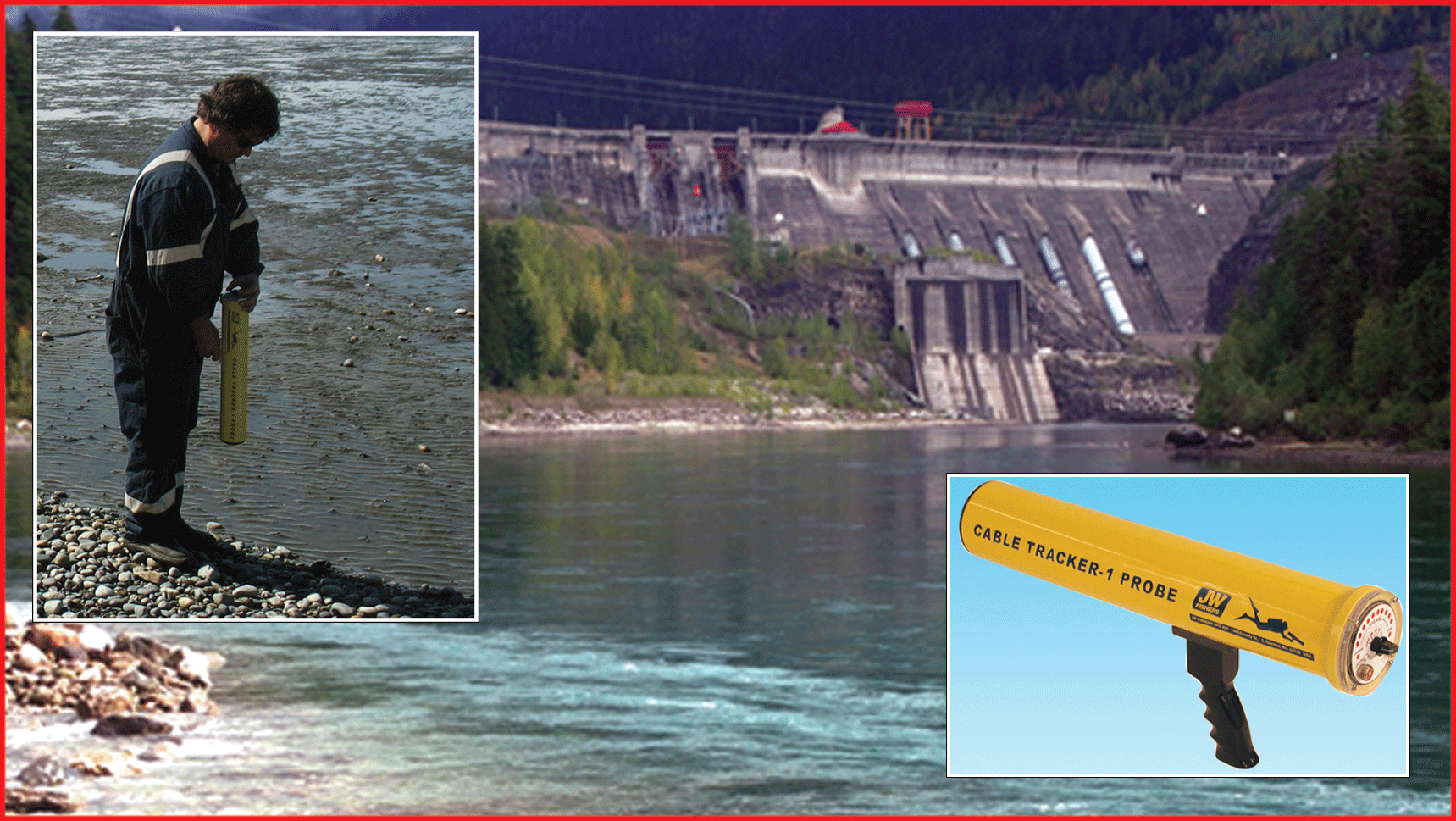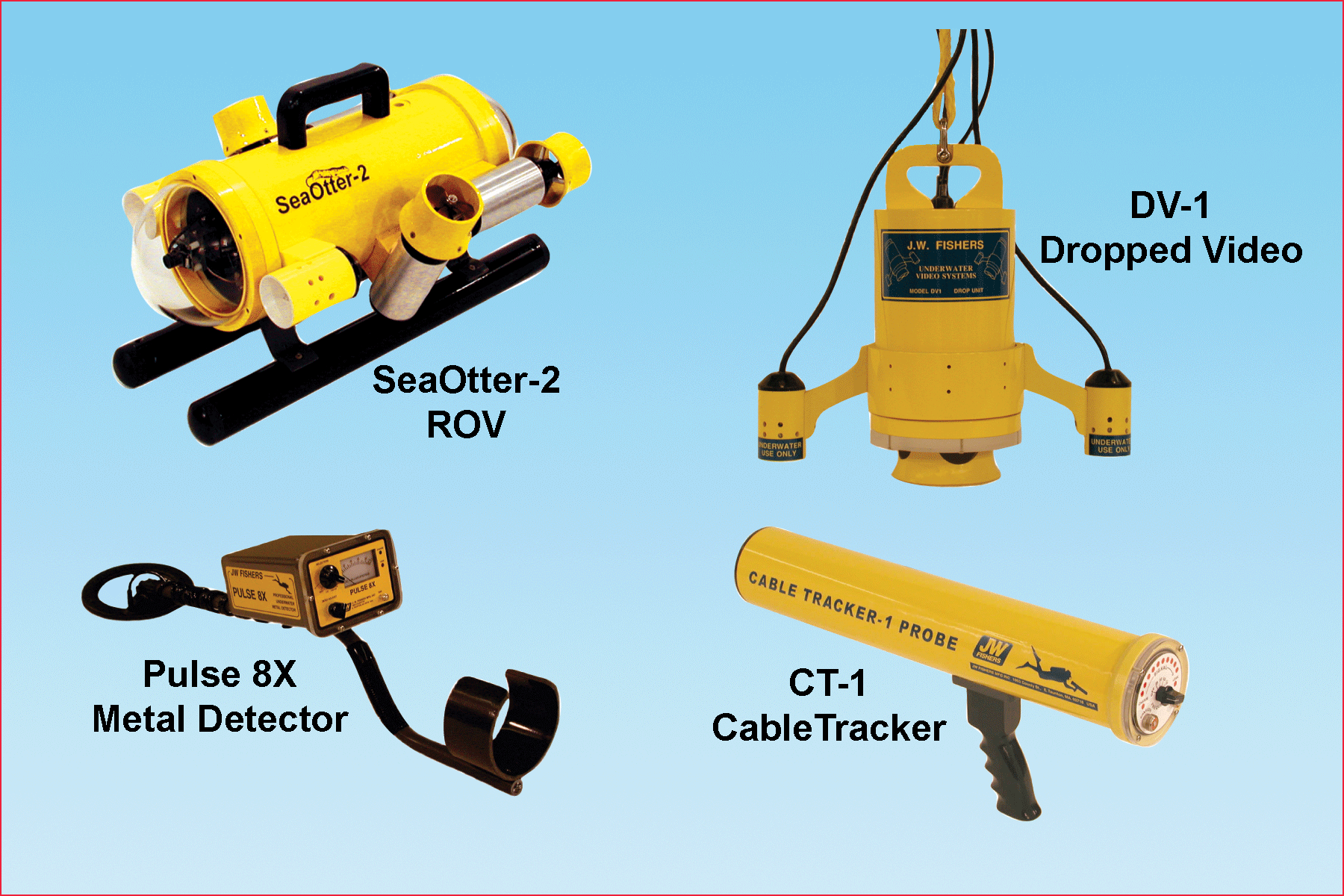
BC Hydro's Revelstoke Dam.
Inset left: contractor uses CT-1 to track cable at water's edge.
Inset right: JW Fishers CT-1 probe.
Statiol, a leading energy company in oil and gas production, recently expanded their operations by purchasing the South Riding Point Storage and Transhipment Terminal on Grand Bahama Island. A primary objective of the acquisition is to strengthen Statiol's market and trading position in North America. The company plans to invest 200 million, half of which will be spent on upgrades at the facility. A significant portion of that money is being used to hire contractors to perform the work. One contractor already on the job is Belgian based Jan de Nul Group. The EPC project (engineering, procurement, & construction) includes removal of an existing pipeline, and the fabrication and installation of a new 42 inch line which will be connected by a spool and riser to an offshore loading platform. One of the tools Jan de Nul is employing is JW Fishers SeaOtter-2 ROV to monitor and inspect the removal of the old line and installation of the new one. The SeaOtter, a highly maneuverable underwater vehicle equipped with two high resolution cameras, allows engineers to watch the construction work from a topside support vessel, and to view it from any angle.
Canada's energy industry is most widely characterized by its hydroelectric plants, but the country also has a budding nuclear industry. Atomic Energy of Canada Ltd (AECL) is a federal corporation charged with the responsibility of managing the country's nuclear program. AECL markets and exports its products and services, which include building nuclear facilities as well as providing maintenance, diagnostics, and waste management. The major R&D effort is carried out at Chalk River Laboratories (CRL). A primary focus of the lab is to develop, support, and advance CANDU nuclear reactor technology. There is also a strong commitment to ensuring that operations at the site have a negligible impact on the health and safety of employees, the public, and the environment. As part of this effort, environmental scientists at CRL are using Fishers DV-1 drop video system to monitor the river's ecosystem. The DV-1 has a high resolution camera mounted in a watertight housing depth rated to 500 feet, and is equipped with two powerful 100 watt lights. Topside the camera connects to the VRM-1, a control console with built-in flat screen ultra bright display and a digital video recorder. Using this system scientists can view and record the activity of marine life, and health of the vegetation, around the drains that output cooling water from the facility.
Another nuclear facility using underwater search equipment is the Nine Mile Point Nuclear Power Station in New York. One of units there had been taken offline to upgrade and replace motors, valves, and seals. Before returning it to service, a FME (foreign materials exclusion) procedure was implemented to minimize the possibility of any foreign material entering the facility. Divers using JW Fishers Pulse 8X underwater metal detector searched the area around the intake pipes that bring in cooling water. Scouring the site with this powerful, commercial grade detector allowed divers to locate every piece of metal in the area, ensuring no metallic debris will be sucked into the plant.
Northern California Power Agency (NCPA) is using an underwater camera system at their facilities. NCPA owns and operates several power plants, including two geothermal units and several hydroelectric units, in a 96% emission-free generation portfolio. The agency is using Fishers DV-1 drop video system to perform inspections at their hydroelectric plants. The drop camera allows the company to perform visual inspections of the dam face, trash racks, tailrace, concrete piers, the headworks, and to check for erosion under the sluiceway aprons. Inspections can be done by company personal as the need arises, eliminating the need to schedule around the availability of an underwater survey crew.
Another hydroelectric company using underwater search equipment is BC Hydro in British Columbia, Canada. BC Hydro operates 30 hydroelectric facilities and 3 natural gas fueled thermal power plants. Recently the company acquired one of Fishers CT-1 cable tracking systems. The cable tracker has the capability of finding and following both live and de-energized power cables, on land and underwater. It can also locate faults and breaks in cables. According to a company spokesman, the CT-1 was supplied to one of the BC Hydro's contractors, commercial diving company CANPAC, who used the CT-1 to locate and track a transmission cable from the point of entry into a lake, across the lake, and out the other side.

Clockwise from top left: JW Fishers SeaOtter-2 ROV, DV-1 dropped video system, CT-1 cable tracker, Pulse 8X metal detector.
